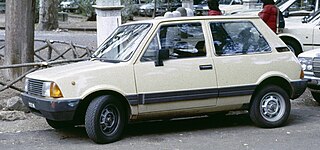
The Ford Sierra is a mid-size car or large family car manufactured and marketed by Ford Europe from 1982–1993, designed by Uwe Bahnsen, Robert Lutz and Patrick le Quément — and noted for its aerodynamic styling producing a drag coefficient of 0.34, a significant improvement over its predecessors.

The Fiat 127 is a supermini car produced by Italian car manufacturer Fiat from 1971 to 1983. It was introduced in 1971 as the replacement for the Fiat 850. Production of the 127 in Italy ended in 1983 following the introduction of its replacement, the Fiat Uno, although the nameplate continued to be used on cars imported from Brazil.

The Autozam Revue is a subcompact car that was sold by Autozam, introduced in 1990. The demise of that marque led to the cars being renamed as the Mazda Revue in some markets. The car was also sold in many export markets as the Mazda 121, where it replaced the previous 121 that had been based on the first-generation Ford Festiva.

The Fiat Oggi is a two-door sedan based on the Fiat 147, a subcompact car produced in South America by Italian automaker Fiat. The Oggi was produced in Brazil from 1983 until 1985, when it was replaced by the Uno-based Prêmio. This car was a response to the new sedans in the Brazilian market, the Chevrolet Monza, the Volkswagen Voyage and later the Ford Escort.

The Alfa Romeo Boxer engine was a water-cooled flat-4 piston engine developed by Alfa Romeo for front-wheel drive, longitudinal applications. It debuted on the Alfasud, which was introduced in 1971 at the Turin Motor Show. In the following decades the Boxer went through several upgrades and powered many Alfa Romeo front-wheel drive cars up to 1996. In 1997 it was phased out and replaced by the transversely-mounted Twin Spark engines.

The Innocenti Mini is an automobile introduced by Innocenti in 1974. The vehicle was a rebodied, three-door hatchback version of the Mini, styled by Bertone. A five-door prototype was developed around 1980, but was never put into production. After having been sold to De Tomaso in 1976, the Innocenti Mini ended up being powered by Daihatsu-sourced three-cylinder engines and continued in production in incrementally updated forms until 1993.

The Hyundai Stellar was a mid-size rear-wheel drive automobile produced by the Hyundai Motor Company to succeed the Ford Cortina, which Hyundai had built under license. The Stellar was launched in July 1983 and was produced until the 1992 model year. The Stellar was designed by Giorgetto Giugiaro using a chassis from the Cortina Mark V.

The Ford Escort is a small family car that was manufactured by Ford of Europe from 1968 until 2000. In total there were six generations, spread across three basic platforms: the original, rear-wheel-drive Mk.1/Mk.2 (1968–1980), the "Erika" front-wheel-drive Mk.3/Mk.4 (1980–1992), and the final CE-14 Mk.5/Mk.6 (1990–2002) version. Its successor, the Ford Focus, was released in 1998, but the final generation of Escort was phased out gradually, with the panel van version ending production in 2002 in favour of the Ford Transit Connect.

The Eagle Vista name has been used on two subcompact cars sold from 1988 to 1992 in Canada. Along with the Eagle Summit, the car replaced the Renault Encore because of Renault's withdrawing from the United States and Canada at that time. It was a rebadged version of the second generation Mitsubishi Mirage. The Vista hatchback and sedans were available with either a 1.5 L 4G15 straight-4, or a 1.6L turbocharged 4G32, and was available with either a 4 or 5-speed manual or a 3-speed automatic transmission. The turbo hatchback came in the GT equipment level, turbo sedans were called LX and carried taller gearing. Turbos were not available with the 4-speed transmission. Hatchbacks and sedans were replaced by the Eagle Summit. Top speeds were 155 km/h (96 mph) or 187 km/h (116 mph) respectively for the naturally aspirated and turbocharged versions.

The Clan Crusader is a fibreglass monocoque British sports car based on running gear from the Hillman Imp Sport, including its Coventry Climax derived, rear-mounted 875 cc engine. It was first made in Washington, Co Durham, England between 1971 and 1974, but since then several efforts have been made to bring the car back to production. Plans were made by Martin Phaff to re-resurrect the Clan in 2009, but nothing seems to have come of the project so far.

Quattroruote is an Italian automobile magazine established by the Marchigian entrepreneur Gianni Mazzocchi in February 1956. Among its regular features it includes information on used car prices.

The Argentine Ford Falcon is a compact car and executive car built by Ford Argentina from 1962 to 1991. Mechanically, it was based on the parent company's first generation Falcon. The Falcon retained the same body style throughout its production, with several substantial facelifts taking place during its lifespan, giving it a more European flavor and bringing it into line with other more contemporary Fords. However, several decades later, it was apparent that it was a 1960s design wearing a 1980s grille. Falcons are still raced in the Turismo Carretera stock car racing series.

The Honda Quint is a subcompact car manufactured by Honda in Japan from 1980 until 1985. It was introduced in February 1980 in Japan as a five-door liftback version of the Honda Civic, being more upscale than the Civic, and was sold at the Honda Verno sales channel in Japan. The Quint was made available to export markets including Europe and Southeast Asia in 1981, with the export name being Honda Quintet. Beginning in 1983, this model was also sold in Australia as the Rover Quintet. The Quint was succeeded by the Honda Quint Integra in 1985.

The GTM Coupé is a Mini based kit car dating back to 1967. GTM is an initialism for "Grand Touring Mini". The car was first shown at the 1967 Racing Car Show and soon afterwards went into production by the Cox brothers from their garage in Hazel Grove, Stockport as the Cox GTM. In 1969 the rights to the design and manufacturing were bought by Howard Heerey and the Cox part of the name was dropped. His father's company Midland Garage took over manufacture of the GTM. In April 1980 ownership changed again to GTM Engineering, who upgraded and continued to manufacture the Coupé until 1995.

The European Ford Granada is an executive car manufactured by Ford Europe from 1972 until 1994.

Marlin is a British sports car manufacturer founded in 1979 in Plymouth as Marlin Engineering and now located in Crediton, Devon, England.

The Checker Aerobus is an automobile manufactured on two different wheelbases by the Checker Motors Corporation from 1962 until 1977. Meant primarily to serve as an airport shuttle, as indicated by the name, it is an extended version of the iconic Checker Marathon. A total of 3,568 Checker Aerobuses of all versions were built.

Eagle Cars Limited was an English company, based in Lancing, West Sussex, originally operated by Allen Breeze, although it has undergone a number of ownership changes since. Originally making a Jeep lookalike called the RV, between 1981 and 1998 they built several iterations of a gull-winged car called the Eagle SS. The SS was based on an American kit car called the Cimbria, and was brought to the UK by Tim Dutton. In 1988 Eagle Cars moved inland, to nearby Storrington.

Carrozzeria Fissore was an Italian coachbuilder located in Savigliano, near Turin (Piedmont).

The Farus is a mid-engined sports automobile built in Brazil by Industria de Veiculos Esportivos LTDA beginning in 1979. The Farus company, located in the southern Brazilian city of Belo Horizonte, was founded in 1979. The name of the company is a portmanteau of FAmilia RUSso, as the cars were built by Alfio Russo and his son Giuseppe. Their original mid-engined ML and TS cars were followed by the larger Farus Quadro, which was also part of an abortive effort to be sold in the United States. After a change of name to TECVAN, the company shut its doors in 1990 as a result of the Plano Collor market liberalization.




























